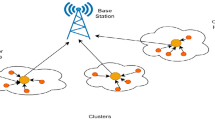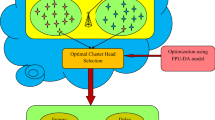Abstract
Wireless sensor networks (WSN) are the integral part of Internet of Things (IoT) applications. They consist of many sensor nodes energized by batteries. These batteries turn out to be dead after the usage of specific duration. The lifespan of the sensor devices depends on its battery life. So it is inevitable that the battery life is to be maintained optimally. Intensifying the data spread in a well-regulated mode helps to increase the lifespan of the sensor devices. Clustering is one of the techniques which help in enhancing the network lifetime of WSN. The optimal selection of cluster heads is a vital parameter. In view of this, a novel fusion cluster head selection algorithm is offered by combining the advantages of LEACH protocol and dragonfly algorithm. The swarm intelligent behavior of dragonfly is deployed to group the sensors and to choose the optimal route to reach the base station. The new algorithm is tested on diverse scenarios of WSNs, by varying the maximum runs and the total sum of sensor nodes. The performance appraisal is made with reference to number of live nodes, dead nodes, and packet transmission ratio. The proposed energy efficient, novel bio-inspired algorithm (NBA) is compared with other existing state-of-the-art algorithms which demonstrate that the new method is effective in broadening network life expectancy satisfactorily.







Similar content being viewed by others
References
Senouci MR, Mellouk A (2019) A robust uncertainty-aware cluster-based deployment approach for WSNs: coverage, connectivity, and lifespan. J Netw Comput Appl 146:102414
Vieira RG, Cunha AM, Ruiz LB, Camargo AP (2018) On the design of a long range WSN for precision irrigation. IEEE Sensors J 18(2):773–780
Krishnan M, Yun S, Jung YM (2019) Enhanced clustering and ACO-based multiple mobile sinks for efficiency improvement of wireless sensor networks. Comput Netw 160:33–40
Kanavall A et al (2009) A flat routing protocol for sensor networks. In: Proceeding of international conference on methods and models in computer science, Delhi, pp 1–5
Yarinezhad R, Hashemi SN (2019) Solving the load balanced clustering and routing problems in WSNs with an FPT-approximation algorithm and a grid structure. Pervasive Mobile Comput 58:101033
Wang J, Yang X, Zhang Z, Wang Y, Kim J-U (2014) A survey about location-basedrouting protocols for wireless sensor network. Adv Sci Technol Lett 48:51–55
Gong D, Yang Y, Pan Z (2013) Energy-efficient clustering in lossy wireless sensor networks. J Parallel Distrib Comput 73(9):1323–1336
Ansari AR, Cho S (2018) CHESS-PC: cluster-HEad selection scheme with power control for public safety networks. IEEE Access 6:51640–51646
Zhang GJ, Hu JW (2014) Adaptive distributed gateway discovery with swarmintelligence in hybrid wireless networks. Int J Future Gener Commun Netw 7(5):137–150
R-C Chen, W-L Chang, C-F Shieh, CC Zou (2012) Using hybrid artificial bee colony algorithm to extend wireless sensor network lifetime. In: Proceedings of the 3rd international conference on innovations in bio-inspired computing and applications (IBICA’12), pp 156–161. IEEE, Kaohsiung, September 2012.
Kong HY (2010) Energy efficient cooperative LEACH protocol for wireless sensor networks. IEEE J Commun Netw 12:358–365
Chand S, Singh S, Kumar B (2014) Heterogeneous HEED protocol for wireless sensor networks. Wirel Pers Commun 77(3):2117–2139
Lindsey S, Raghavendra CS (2002) PEGASIS: power-efficient gathering in sensor information systems. In: IEEE aerospace and electronic systems society proc of the IEEE aerospace conf, pp 1125–1130
Li C, Ye M, Chen G, Wu J (2005) An energy-efficient unequal clustering mechanism for wireless sensor networks. In: 2nd IEEE Int Conf Mob Ad-hoc Sens Syst MASS 2005 2005, pp 597–604. https://doi.org/10.1109/MAHSS.2005.1542849.
Nigam GK, Dabas C (2020) ESO-LEACH: PSO based energy efficient clustering in LEACH. J King Saud Univ Comput Inf Sci 32(10):1210–1211
Shankar T, Karthikeyan Sivasankar Rajesh APA (2017) Hybrid approach for optimal cluster head selection in WSN using leach and monkey search algorithms. J Eng Sci Technol 2(12):506–517
Dorigo M, Maniezzo V, Colorni A (1996) The ant system: optimization by a colony of cooperating agents. IEEE Trans Syst Man Cybern B 26
Omran M, Salman A, Engelbrecht AP (2002) Image classification using particle swarm optimization. In: Conference on simulated evolution and learning, vol 1, pp 370–374
Akila IS, Venkatesan R (2016) A fuzzy based energy-aware clustering architecture for cooperative communication in WSN. Comput J 59(10):1551–1562
Meng X, Gao X, Zhang H (2014) A new bio-inspired algorithm: chicken swarm optimization. In: Tan Y, Shi Y, Coello CAC (eds) Advances in swarm intelligence ICSI (Lecture notes in computer science), vol 8794. Springer, Cham
Barzin A, Sadeghieh A, Zareh HK, Honarvar M (2019) Hybrid swarm intelligence-based clustering algorithm for energy management in wireless sensor networks. J Ind Syst Eng 12(3):78–106
Akyildiz IF, Su W, Sankarasubramaniam Y, Cayirci E (2002) Wireless sensor networks: a survey. Comput Netw 38:393–422. https://doi.org/10.1016/S1389-1286(01)00302-4
Anastasi G, Conti M, Di Francesco M (2009) Passarella Energy conservation in wireless sensor networks: a survey. Ad Hoc Netw 7:537–568. https://doi.org/10.1016/j.adhoc.2008.06.003
Zang HN, Zhang SJ, Hapeshi KA (2010) Review of nature-inspired algorithms. J Bionic Eng 7:S232–S237
Pazhani Raja N, Paul PV, Roja G, Shanmugapriya K, Sonali B (2017) A study on recent bio-inspired optimization algorithms. In: 2017 4th international conference on signal processing, communication and networking (ICSCN). https://doi.org/10.1109/icscn.2017.8085674
Meraihi Y, Ramdane-Cherif A, Acheli D, Mahseur M (2020) Dragonfly algorithm: a comprehensive review and applications. Neural Comput Appl. https://doi.org/10.1007/s00521-020-04866-y
Russell RW, May ML, Soltesz KL, Fitzpatrick JW (1998) Massive swarm migrations of dragonflies (Odonata) in eastern North America. Am Midl Nat 140(2):325–342
Ergen SC, Varaiya P (2007) PEDAMACS: power efficient and delay aware medium access protocol for sensor networks. IEEE Trans Mob Comput 5(7):920–930
Author information
Authors and Affiliations
Corresponding author
Additional information
Publisher's Note
Springer Nature remains neutral with regard to jurisdictional claims in published maps and institutional affiliations.
Rights and permissions
About this article
Cite this article
Devassy, D., Immanuel Johnraja, J. & Paulraj, G.J.L. NBA: novel bio-inspired algorithm for energy optimization in WSN for IoT applications. J Supercomput 78, 16118–16135 (2022). https://doi.org/10.1007/s11227-022-04505-4
Accepted:
Published:
Issue Date:
DOI: https://doi.org/10.1007/s11227-022-04505-4




